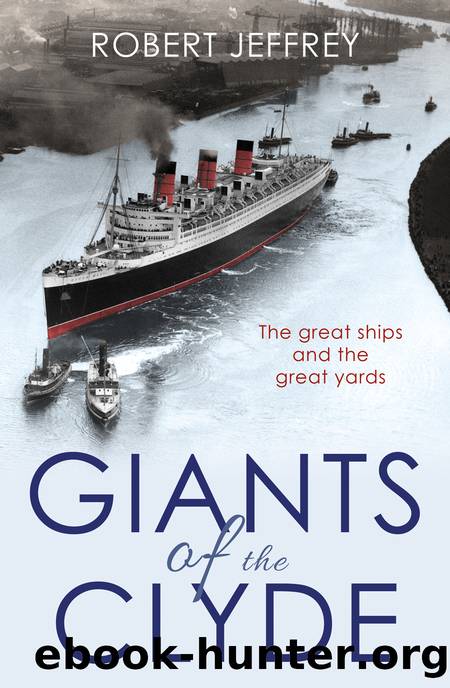Giants of the Clyde by Robert Jeffrey

Author:Robert Jeffrey
Language: eng
Format: epub
Publisher: Black & White Publishing
Published: 2017-05-29T00:00:00+00:00
12
The Blue Riband, Submarine Attack and Political Fury
The building of famous warships is, of course, only part of the illustrious history of John Brownâs. For those with an interest in ships â including the men and women who built them â it is the glamour of the great liners that left Clydebank and sailed down the Firth of Clyde and out into the oceans of the world that are perhaps most remembered. The story of one in particular, the Lusitania, is still, more than 100 years after it sank off southern Ireland, a poignant mixture of seagoing triumph and tragedy. The triumph was being for a time the worldâs largest passenger ship and the holder of the Blue Riband as the fastest ship on the Atlantic. The tragedy was the death of almost 2,000 passengers and crew when the German submarine U-20 torpedoed her on 7 May 1915.
The Blue Riband was the most highly sought award in the world of shipping from around 1910 and was proudly claimed by ships of many nations. The name Blue Riband came from a term much used in horse racing. For ships it was an unofficial title of a competition with unwritten rules that meant that a liner with the speediest time for an eastbound Atlantic crossing could be called a ârecord breakerâ but the real award only went to the fastest westbound crossing which was considered the more difficult since it went against the Gulf Stream. It is a demonstration of Britainâs importance in world shipping that of the thirty-five liners to hold the record thirteen were Cunarders. Though, in an indication of what was to come in the current world of super cruise liners, the last holder of the famous old accolade was the stylish American liner United States. Indirectly the trophy was responsible for the construction of the Lusitania and her sister ship the Mauretania (built by Swan Hunter).
Cunard had been losing business to the fast ships of German companies Norddeutscher Lloyd (NDL) and the Hamburg America Line (HAPAG). The NDL liner Kaiser Wilhelm der Grosse had taken the Blue Riband from Campania and later HAPAGâs Deauchland also claimed it, among other European liners. If Britain was again to rule the peacetime waves, new ships were needed and the first of the new flyers was to be built at Brownâs. This work involved more than building a new ship. The whole of Brownâs yard needed to be organised so that the ship could be launched diagonally across the Clyde where the river was at its widest, at the point the Cart joined it. The problem was that the ship was nearly 800 feet long and the river was only 610 feet wide. A new slipway taking up the space of two old ones had to be built. This was costly and almost £10,000 was spent on dredging the river. A further sum of almost £70,000, massive for those days, was spent on a new gas and electric plant, extending the dock and providing a huge new crane.
Download
This site does not store any files on its server. We only index and link to content provided by other sites. Please contact the content providers to delete copyright contents if any and email us, we'll remove relevant links or contents immediately.
Small Unmanned Fixed-wing Aircraft Design by Andrew J. Keane Andras Sobester James P. Scanlan & András Sóbester & James P. Scanlan(32678)
Navigation and Map Reading by K Andrew(4957)
Endurance: Shackleton's Incredible Voyage by Alfred Lansing(4622)
And the Band Played On by Randy Shilts(2075)
Wild Ride by Adam Lashinsky(1896)
The Box by Marc Levinson(1892)
Top 10 Prague (EYEWITNESS TOP 10 TRAVEL GUIDES) by DK(1889)
The Race for Hitler's X-Planes: Britain's 1945 Mission to Capture Secret Luftwaffe Technology by John Christopher(1762)
The One Percenter Encyclopedia by Bill Hayes(1748)
Trans-Siberian Railway by Lonely Planet(1660)
Girls Auto Clinic Glove Box Guide by Patrice Banks(1649)
Looking for a Ship by John McPhee(1603)
Batavia's Graveyard by Mike Dash(1579)
TWA 800 by Jack Cashill(1560)
Fighting Hitler's Jets: The Extraordinary Story of the American Airmen Who Beat the Luftwaffe and Defeated Nazi Germany by Robert F. Dorr(1540)
Good with Words by Patrick Barry(1534)
Troubleshooting and Repair of Diesel Engines by Paul Dempsey(1526)
Ticket to Ride by Tom Chesshyre(1518)
Bligh by Rob Mundle(1513)
